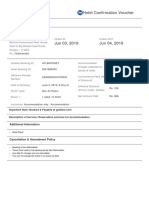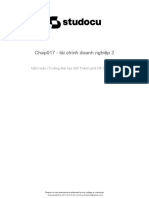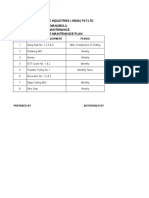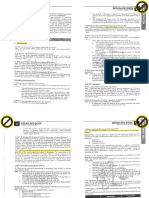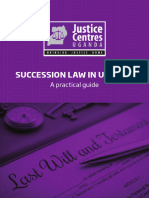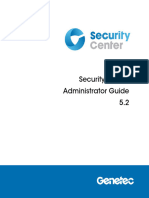ch17 Test
ch17 Test
Uploaded by
nhutran.31221024053Copyright:
Available Formats
ch17 Test
ch17 Test
Uploaded by
nhutran.31221024053Original Title
Copyright
Available Formats
Share this document
Did you find this document useful?
Is this content inappropriate?
Copyright:
Available Formats
ch17 Test
ch17 Test
Uploaded by
nhutran.31221024053Copyright:
Available Formats
lOMoARcPSD|20508391
Ch17 - test
Principles of Finance (Imam Abdulrahman Bin faisal University)
Scan to open on Studocu
Studocu is not sponsored or endorsed by any college or university
Downloaded by NHU? TR?N KHA?NH HA? (nhutran.31221024053@st.ueh.edu.vn)
lOMoARcPSD|20508391
Ch17
1) If a firm were to ________, the firm’s cash flows would decrease.
A) decrease the use of leverage
B) decrease costs
C) increase sales due to an improved economy
D) incur costs associated with bankruptcy
E) decrease the interest rate paid on its debt
2) The ________ are the explicit costs, such as legal expenses, associated with corporate
default.
A) debt flotation costs
B) beta conversion costs
C) direct costs of financial distress
D) indirect bankruptcy costs
E) unlevered costs of capital
3) According to White, Altman, and Weiss, the estimated direct cost of financial distress as
a percentage of the market value of a firm is:
A) 3 percent.
B) 5 percent.
C) 8 percent.
D) 1 percent.
E) 10 percent.
4) Which one of the following is a direct, rather than an indirect, cost of financial distress?
Version 1 1
Downloaded by NHU? TR?N KHA?NH HA? (nhutran.31221024053@st.ueh.edu.vn)
lOMoARcPSD|20508391
A) Key employee leaving for another job due to concerns over job security given the
company’s financial status
B) Loss of a key supplier due to late payments to that supplier
C) Fees paid to financial advisors related to bankruptcy matters
D) Loss of customers due to concerns the company will close
E) Money spent to send a mailing to customers dispelling any and all financial distress
concerns about the company
5) The costs incurred because of conflicts of interest between stockholders and bondholders
are known as ________ costs.
A) trustee
B) financial distress
C) dealer
D) agency
E) underwriting
6) An indirect cost of bankruptcy is the effect that a potential bankruptcy has on the firm’s
decisions. The general result is that:
A) the firm will rank all projects and select the project which results in the highest
expected firm value.
B) bondholders expropriate value from stockholders by selecting high-risk projects.
C) stockholders expropriate value from bondholders by selecting high-risk projects.
D) the firm will always select the lowest-risk project available.
E) the firm will select only all-equity financed projects.
7) One of the indirect costs of bankruptcy is the incentive to underinvest. Such
underinvestment generally would result in:
Version 1 2
Downloaded by NHU? TR?N KHA?NH HA? (nhutran.31221024053@st.ueh.edu.vn)
lOMoARcPSD|20508391
A) the firm selecting all projects with positive NPVs.
B) the firm turning down positive NPV projects that would clearly be accepted if the
firm were all-equity financed.
C) bondholders contributing the full amount of any new investment, but both
stockholders and bondholders sharing in the benefits of those investments.
D) shareholders making decisions based on the best interests of the bondholders.
E) the firm accepting more projects than it would if the probability of bankruptcy was
ignored.
8) Which one of the following actions best exemplifies “milking the property”?
A) A firm paying a premium to acquire a competitor
B) A firm demanding a premium to be acquired without a proxy fight
C) A firm with high financial distress paying additional dividends
D) An all-equity firm repurchasing shares
E) A firm with high financial distress using expected dividends to repay debt
9) Shareholders sometimes pursue selfish strategies when the firm experiences financial
distress. These actions generally result in:
A) no action by debtholders since such strategies are shareholder concerns.
B) agency costs to bondholders.
C) investments with risks similar to those of the current firm.
D) undertaking scale-enhancing projects.
E) lower agency costs, as shareholders have more control over the firm’s assets.
10) Bondholders tend to offset the effects of selfish strategies implemented by shareholders
by:
Version 1 3
Downloaded by NHU? TR?N KHA?NH HA? (nhutran.31221024053@st.ueh.edu.vn)
lOMoARcPSD|20508391
A) restructuring their loans to provide additional time to the firm to make repayment.
B) subordinating their bankruptcy position to the shareholders.
C) agreeing to reduce the outstanding principal balances on their loans.
D) agreeing to reduce the interest rate on existing loans.
E) increasing the interest rate on monies loaned to the firm.
11) Covenants restricting additional borrowings primarily protect the:
A) shareholders’ residual interests in the firm.
B) debtholders from the added risk of dilution of their claims.
C) debtholders from changes in market interest rates.
D) managers by avoiding agency costs.
E) shareholders from agency costs.
12) If a firm issues debt and includes protective covenants in the indenture, then the debt will
probably be issued at _____ similar debt without the covenants.
A) a variable interest rate rather than the fixed rate paid on
B) a lower interest rate than
C) a significantly higher interest rate than
D) an interest rate equal to that of
E) a slightly higher interest rate than
13) Which one of the following actions is most related to a positive covenant?
Version 1 4
Downloaded by NHU? TR?N KHA?NH HA? (nhutran.31221024053@st.ueh.edu.vn)
lOMoARcPSD|20508391
A) Limiting the amount of the firm’s dividends
B) Avoiding a merger while a debt remains unpaid
C) Furnishing financial statements to the firm’s lenders
D) Not issuing any additional long-term debt
E) Not selling any major assets without lender approval
14) Suppose a potential bondholder requires that the indenture agreement include a limit on
dividend distributions by the bond’s issuer and also a restriction on the sale of the issuer’s assets.
In this case, the bondholder is most likely concerned about:
A) shareholder claims being diluted.
B) shareholders claiming all of the residual profits of the firm.
C) increasing interest rates.
D) shareholders transferring the firm’s assets to themselves.
E) shareholders earning a higher return on their investment in the firm than the
bondholders earn on their debt.
15) Which one of the following statements represents a difference between business entities
in Japan and in the United States?
A) Lenders in Japan frequently also take ownership positions in firms to which they
lend.
B) Debt-equity ratios tend to be higher in the U.S. than they are in Japan.
C) There tends to be greater agency issues between stockholders and bondholders in
Japan as compared to the U.S.
D) Bondholders in Japan are prohibited from also being shareholders in the same firm.
E) The debt-equity ratios for firms in Japan and in the U.S. tend to be relatively equal.
16) Which one of the following parties holds a marketable claim on a firm’s assets?
Version 1 5
Downloaded by NHU? TR?N KHA?NH HA? (nhutran.31221024053@st.ueh.edu.vn)
lOMoARcPSD|20508391
A) Customers
B) Employees
C) Bondholders
D) Internal Revenue Service
E) State tax authorities
17) The value of a firm is maximized when the:
A) cost of equity is maximized.
B) tax rate is zero.
C) levered cost of capital is maximized.
D) weighted average cost of capital is minimized.
E) debt-equity ratio is minimized.
18) The optimal capital structure has been achieved when the:
A) debt-equity ratio is equal to 1.
B) weight of equity is equal to the weight of debt.
C) cost of equity is maximized given a pretax cost of debt.
D) debt-equity ratio is such that the cost of debt exceeds the cost of equity.
E) present value of the financial distress costs equals the present value of the tax shield
on debt.
19) In a world with taxes and financial distress, when a firm is operating with the optimal
capital structure the:
Version 1 6
Downloaded by NHU? TR?N KHA?NH HA? (nhutran.31221024053@st.ueh.edu.vn)
lOMoARcPSD|20508391
A) debt-equity ratio will be minimized.
B) weighted average cost of capital will be maximized.
C) firm will be all-equity financed.
D) required return on assets will be at its maximum point.
E) overall benefits of debt have all been realized.
20) The optimal capital structure of a firm _____ the value of marketable claims and _____
the value of nonmarketable claims against the cash flows of the firm.
A) minimizes; minimizes
B) minimizes; maximizes
C) maximizes; minimizes
D) maximizes; maximizes
E) equates; (leave blank)
21) The MM theory with taxes implies that firms should issue maximum debt. In practice,
this does not occur because:
A) debt is more risky than equity.
B) bankruptcy is a disadvantage to debt.
C) the weighted average cost of capital is inversely related to the debt-equity ratio.
D) the weighted average cost of capital is directly related to the debt-equity ratio.
E) U.S. regulations require the debt-equity ratio of publicly-traded firms to be in the
range of .3 to .7.
22) Assuming the interest on the debt is fully tax deductible, when firms issue additional
debt, the present value of the tax shield on debt _____ and the present value of the financial
distress costs _____.
Version 1 7
Downloaded by NHU? TR?N KHA?NH HA? (nhutran.31221024053@st.ueh.edu.vn)
lOMoARcPSD|20508391
A) decreases; decreases
B) increases; increases
C) decreases; remains constant
D) decreases; increases
E) increases; remains constant
23) Horizon Mortgage is considering issuing $2.5 million in bonds. The finance department
at Horizon has stated that issuing the bonds will decrease the value of the firm. Accordingly, you
know the finance department believes the firm:
A) currently is all-equity financed and adding debt will cause a decrease in firm value.
B) wants to issue too few bonds to obtain the most benefit from debt.
C) will suffer from a decrease in its WACC if the bonds are issued.
D) is at, or has exceeded, its optimal debt-equity ratio.
E) will realize greater tax benefits by issuing equity securities.
24) Which one of the following statements is true?
A) A firm with low anticipated profits will likely take on a high level of debt.
B) A successful firm will probably be all-equity financed.
C) Rational firms raise debt levels when profits are expected to decline.
D) Rational investors are likely to infer a firm is more valuable when its debt level
declines.
E) Investors will generally view an increase in debt as a positive sign for the firm’s
future value.
25) A decrease in a firm’s use of debt tends to imply:
Version 1 8
Downloaded by NHU? TR?N KHA?NH HA? (nhutran.31221024053@st.ueh.edu.vn)
lOMoARcPSD|20508391
A) an increase in the firm’s market value.
B) an increase in future dividend payouts.
C) a decrease in the firm’s stock price.
D) a decrease in the firm’s position within its industry.
E) a decline in managerial efficiency.
26) For the next 30 days, the bondholders of Sound Effects have the option of exchanging
their bonds for common shares of the firm’s stock. As a result of these exchanges, you should
expect the firm’s debt-equity ratio to ________ and the stock price to ________.
A) decrease; decrease
B) decrease; remain constant
C) decrease; increase
D) increase; increase
E) increase; remain constant
27) The free cash flow hypothesis states that:
A) firms with greater free cash flow will pay higher dividends thereby reducing the risk
of financial distress.
B) firms with greater free cash flow should issue new equity to help minimize the
wasting of resources by managers.
C) issuing debt requires payments to creditors thereby reducing the ability of managers
to waste resources.
D) firms should reduce their debt levels as their level of free cash flow rises.
E) firms with higher levels of free cash flow should reward their managers with
bonuses.
28) Issuing new debt instead of new equity in a closely held firm is most apt to cause:
Version 1 9
Downloaded by NHU? TR?N KHA?NH HA? (nhutran.31221024053@st.ueh.edu.vn)
lOMoARcPSD|20508391
A) the owner-manager to work less hard and shirk duties.
B) the owner-manager to consume more perquisites because the cost is passed to the
debtholders.
C) both more shirking and perquisite consumption since the government provides a tax
shield on debt.
D) agency costs to fall as owner-managers do not need to worry about other
shareholders.
E) the owner-manager to reduce shirking and perquisite consumption.
29) According to the pecking-order theory, when funding capital projects, firms should:
A) use internal financing first.
B) always issue debt so the market won’t know when managers believe the stock is
overvalued.
C) issue new equity first.
D) issue debt first.
E) always issue equity to avoid financial distress costs.
30) According to the pecking-order theory, a firm’s leverage ratio is determined by:
A) the value of the tax benefit of debt.
B) equating the tax benefit of debt to the financial distress costs of debt.
C) the firm’s financing needs.
D) the market rate of interest.
E) the profitability of the firm.
31) Which one of the following is not implied by the pecking-order theory?
Version 1 10
Downloaded by NHU? TR?N KHA?NH HA? (nhutran.31221024053@st.ueh.edu.vn)
lOMoARcPSD|20508391
A) Profitable firms tend to use less debt than unprofitable firms.
B) Companies like having financial slack.
C) Companies prefer to borrow up to the point where the financial distress costs offset
the tax benefit of debt.
D) There is no target debt-equity ratio for a firm.
E) Firms tend to accumulate cash in anticipation of future projects.
32) The introduction of personal taxes may reveal a disadvantage to the use of corporate debt
if the personal tax rate on:
A) the distribution of income to stockholders is less than the personal tax rate on interest
income.
B) the distribution of income to stockholders is greater than the personal tax rate on
interest income.
C) the distribution of income to stockholders is equal to the personal tax rate on interest
income.
D) interest income is zero.
E) dividends and interest are equal.
33) Ignore financial distress costs. When (1 − TC) × (1 − TS) = (1 − TB), then firms:
A) should be all-equity financed.
B) need to maintain a debt-equity ratio of .5.
C) tend to be indifferent between issuing debt or issuing equity.
D) discover that both dividends and interest payments are non-deductible business
expenses.
E) can reduce their taxes by increasing their dividend payouts.
Version 1 11
Downloaded by NHU? TR?N KHA?NH HA? (nhutran.31221024053@st.ueh.edu.vn)
lOMoARcPSD|20508391
34) Of the following five U.S. industries, which one tends to have the highest level of debt as
a percentage of the market value of debt plus equity?
A) Electric utilities
B) Airlines
C) Fabric apparel
D) Drugs
E) Steel works
35) Studies have found that firms with large investments in tangible assets tend to have:
A) higher financial distress costs than firms with comparable investments in intangible
assets.
B) zero debt.
C) higher target debt-equity ratios than firms that primarily invest in intangible assets.
D) the highest financial distress costs of any firm per dollar of debt.
E) the same capital structure as firms that specialize in intangible asset investments.
36) When determining a target debt-equity ratio, which group of factors is generally
considered to be the most important?
A) Taxes, asset types, and inflation rate
B) Asset types, current operating income, and inflation rates
C) Taxes, current operating income, and future operating income
D) Taxes, asset types, and uncertainty of operating income
E) Interest rates, inflation rates, and tax rates
37) Which one of the following is not empirically correct?
Version 1 12
Downloaded by NHU? TR?N KHA?NH HA? (nhutran.31221024053@st.ueh.edu.vn)
lOMoARcPSD|20508391
A) Some firms use no debt.
B) The capital structure of a firm can vary significantly over time.
C) Capital structures are fairly constant across industries.
D) Debt levels across industries vary widely.
E) Debt ratios in most countries are considerably less than 100 percent.
38) The optimal capital structure:
A) is identical for all firms in the same industry.
B) will remain constant over time unless the firm makes an acquisition.
C) of a particular firm can change if tax rates change.
D) places more emphasis on the operations of a firm rather than the financing of a firm.
E) is unaffected by changes in the financial markets.
39) As compared to firms in other countries, corporations in the U.S. tend to:
A) have a median leverage ratio that’s equal to the average international median
leverage ratio.
B) underutilize debt.
C) rely less on equity financing than they should.
D) have extremely high debt-equity ratios.
E) have relatively high leverage ratios due to the tax benefits gained.
40) In general, U.S. firms:
Version 1 13
Downloaded by NHU? TR?N KHA?NH HA? (nhutran.31221024053@st.ueh.edu.vn)
lOMoARcPSD|20508391
A) tend to overweigh debt in relation to equity.
B) that are highly profitable tend to have lower target debt-equity ratios than
unprofitable firms.
C) tend to maintain similar capital structures across all industries.
D) tend to maximize the use of every dollar of the tax benefits of debt.
E) that are family-owned tend to have very low levels of debt.
41) Many firms base their actual capital structure decisions on which two factors?
A) Inflation and tax rates
B) Interest and tax rates
C) Need for financial slack and current interest rates
D) Need for financial slack and industry averages
E) Types of assets held and current interest rates
299) What is the pecking-order theory and what are the implications that arise from this
theory?
Version 1 14
Downloaded by NHU? TR?N KHA?NH HA? (nhutran.31221024053@st.ueh.edu.vn)
lOMoARcPSD|20508391
The pecking order theory states that 昀椀rms should 昀椀rst use internal 昀椀nancing, which includes retained
earnings. If the 昀椀rm then requires external 昀椀nancing, it should issue the safer securi琀椀es, such as debt,
昀椀rst
The implica琀椀ons of this theory are: ∙ There is no target amount of leverage. ∙ Pro昀椀table 昀椀rms use less
debt. ∙ Companies like 昀椀nancial slack
301) Is there an easily quantifiable debt-equity ratio that will maximize the value of a firm?
Why or why not?
In a world with taxes, economic uncertainty, and 昀椀nancial distress costs, there are both bene昀椀ts and
costs to higher debt loads but there is no way to target exactly what the ideal capital structure should be
302) Describe some of the sources of business risk and financial risk. Do financial decision
makers have the ability to trade off one type of risk for another type of risk?
Some of the observed varia琀椀ons in capital structures across industries re昀氀ect the di昀昀erences in the
nature of the industries themselves, i.e., business risk. Similarly, intui琀椀on would suggest that 昀椀rms with
large capital requirements and stable cash 昀氀ows (e.g., electric u琀椀li琀椀es) are more likely to be willing to
raise funds via large amounts of borrowing (昀椀nancial risk). Alterna琀椀vely, 昀椀rms with lower tangible asset
Version 1 15
Downloaded by NHU? TR?N KHA?NH HA? (nhutran.31221024053@st.ueh.edu.vn)
lOMoARcPSD|20508391
needs and highly uncertain cash 昀氀ows (e.g., small so昀琀ware companies) are more likely to employ equity.
Thus, 昀椀rms with lower business risk may tend to accept higher levels of 昀椀nancial risk and vice versa.
Thus, 昀椀rms can and do trade o昀昀 昀椀nancial and business risks
Version 1 16
Downloaded by NHU? TR?N KHA?NH HA? (nhutran.31221024053@st.ueh.edu.vn)
You might also like
- Goibibo Hotel BillDocument4 pagesGoibibo Hotel BillBanani Das33% (3)
- SIE Exam Practice Question Workbook: Seven Full-Length Practice Exams (2024 Edition)From EverandSIE Exam Practice Question Workbook: Seven Full-Length Practice Exams (2024 Edition)Rating: 5 out of 5 stars5/5 (1)
- Managerial Economics 7th Edition Keat Young Erfle Test BankDocument5 pagesManagerial Economics 7th Edition Keat Young Erfle Test Bankcasey100% (30)
- Final ADM 3350Document13 pagesFinal ADM 3350Dan Grimsey100% (1)
- Marine Engineering ResumeDocument3 pagesMarine Engineering ResumeChen Onato Tamayo56% (16)
- Corporate Finance Quiz Test ChaptersDocument250 pagesCorporate Finance Quiz Test ChaptersLinh Đỗ ThùyNo ratings yet
- Chapter 17 Capital Structure-TestbankDocument12 pagesChapter 17 Capital Structure-TestbankLâm Thanh Huyền Nguyễn100% (1)
- Module 3 Guided Formatives - Version2Document55 pagesModule 3 Guided Formatives - Version2Dan DavisNo ratings yet
- Principles of Information Security 4th Edition Whitman Test BankDocument5 pagesPrinciples of Information Security 4th Edition Whitman Test Bankxasuhymu100% (3)
- Agreement To Sell Plot / HouseDocument2 pagesAgreement To Sell Plot / HouseMore Ideas50% (2)
- TB TCDN Chap 17Document51 pagesTB TCDN Chap 17Như Quỳnh ÂuNo ratings yet
- Chương 17Document11 pagesChương 17Như Quỳnh ÂuNo ratings yet
- Questioins - Ch1 - GovrDocument4 pagesQuestioins - Ch1 - GovrMohamed HegazyNo ratings yet
- FIN 320 - Sample Final Exam 2011Document7 pagesFIN 320 - Sample Final Exam 2011rawrissexyNo ratings yet
- 2017 Acf - Revision1Document15 pages2017 Acf - Revision1Leezel100% (1)
- Test Bank Chapter 16Document23 pagesTest Bank Chapter 16rolathaer1996No ratings yet
- 07 Fundamentals of Capital BudgetingDocument18 pages07 Fundamentals of Capital BudgetingWesNo ratings yet
- Fin QuestionsDocument20 pagesFin QuestionsMaria RahmanNo ratings yet
- MAF603-QUESTION TEST 2 - Jan 2021Document10 pagesMAF603-QUESTION TEST 2 - Jan 2021fareen faridNo ratings yet
- FINC521-Most Important QuestionsDocument24 pagesFINC521-Most Important QuestionsAll rounder NitinNo ratings yet
- Chapter 13 Study NotesDocument18 pagesChapter 13 Study NotesRajaa BerryNo ratings yet
- Solution Midterm Exam Adm 3350 M 2013Document10 pagesSolution Midterm Exam Adm 3350 M 2013SKNo ratings yet
- Ross12e Chapter01 TBDocument12 pagesRoss12e Chapter01 TBHải YếnNo ratings yet
- AcF302 EXAM 2023Document15 pagesAcF302 EXAM 2023Rebouhate InassNo ratings yet
- ADVANCED STRATEGIC FINANCIAL MANAGEMENT (New)Document19 pagesADVANCED STRATEGIC FINANCIAL MANAGEMENT (New)TAUQEER AHMADNo ratings yet
- 804 MCQDocument15 pages804 MCQOlamilekan JuliusNo ratings yet
- O D e V Leverage and Capital StructureDocument9 pagesO D e V Leverage and Capital StructureYaldiz YaldizNo ratings yet
- Financial Management QuestionsDocument9 pagesFinancial Management QuestionsNiyati JainNo ratings yet
- FMSM Dec 22 Answers - DraftDocument23 pagesFMSM Dec 22 Answers - Draftjacob michelNo ratings yet
- Chapter 1 HomeworkDocument7 pagesChapter 1 HomeworkElmtreee 12341234No ratings yet
- ACF End Term 2015Document8 pagesACF End Term 2015SharmaNo ratings yet
- Homework 3 PDFDocument7 pagesHomework 3 PDFuniguy123No ratings yet
- Fin202 Sem.2 2019 MCQ New QDocument31 pagesFin202 Sem.2 2019 MCQ New QEy B0ssNo ratings yet
- Long Term FinancingDocument4 pagesLong Term FinancingRose PinkNo ratings yet
- 9.1 Overview of The Cost of CapitalDocument21 pages9.1 Overview of The Cost of CapitalTawan VihokratanaNo ratings yet
- Answers For BA1 Revision QuestionsDocument8 pagesAnswers For BA1 Revision QuestionsNivneth PeirisNo ratings yet
- Chapter 2 The Firm and Its Goals: Managerial Economics, 7e (Keat)Document5 pagesChapter 2 The Firm and Its Goals: Managerial Economics, 7e (Keat)Gabrielle Joshebed AbaricoNo ratings yet
- Muhmmad Waqas Awais: Financial ManagementDocument25 pagesMuhmmad Waqas Awais: Financial Managementaestheticvibes4646No ratings yet
- Corporate Finance Practice QuestionsDocument11 pagesCorporate Finance Practice Questionsabhimani5472No ratings yet
- FIN203 Tutorial 2 QDocument6 pagesFIN203 Tutorial 2 Q黄于绮No ratings yet
- Questions LiquidityDocument3 pagesQuestions LiquidityperiNo ratings yet
- FNCE341 Assignment Worksheet 1Document3 pagesFNCE341 Assignment Worksheet 1Khristos ZuluNo ratings yet
- Review For Capital Structure and Dividend Policy - Version1Document10 pagesReview For Capital Structure and Dividend Policy - Version1itandonNo ratings yet
- Individual Ass One - FM2Document6 pagesIndividual Ass One - FM2Alex HaymeNo ratings yet
- Exam II Version BDocument12 pagesExam II Version B조서현No ratings yet
- MCQDocument9 pagesMCQsk_lovNo ratings yet
- ADL 55 Management of Financial Services V2Document7 pagesADL 55 Management of Financial Services V2solvedcareNo ratings yet
- Problem Set 1Document5 pagesProblem Set 1PaulNo ratings yet
- Chapter 05 Testbank - Good Chapter 05 Testbank - GoodDocument58 pagesChapter 05 Testbank - Good Chapter 05 Testbank - GoodThu NguyenNo ratings yet
- FINC02Document204 pagesFINC02choprarishabh98No ratings yet
- Chapter 2 Test BankDocument7 pagesChapter 2 Test Bankrajalaxmi rajendranNo ratings yet
- 10 28 QuestionsDocument5 pages10 28 QuestionstikaNo ratings yet
- FinMan 1 - Prelim Reviewer 2017Document17 pagesFinMan 1 - Prelim Reviewer 2017Rachel Dela Cruz100% (1)
- ADM 3350 Final Exam MCDocument15 pagesADM 3350 Final Exam MCNick SokolonNo ratings yet
- Chapter 1 3Document17 pagesChapter 1 3Hieu Duong Trong100% (3)
- Corfin Test Chap1Document10 pagesCorfin Test Chap1icecream0745No ratings yet
- MCQ - Part 01 Students - Intermediate Accounting IIDocument6 pagesMCQ - Part 01 Students - Intermediate Accounting IIAbdulaziz FaisalNo ratings yet
- R22 Capital Structure Q Bank PDFDocument6 pagesR22 Capital Structure Q Bank PDFZidane KhanNo ratings yet
- CH 7 TQDocument15 pagesCH 7 TQManuel Urda Rodriguez0% (1)
- Practice Questions: Chapters 1 and 2 of Bodie, Kane, Marcus Investments Part I: Multiple ChoiceDocument6 pagesPractice Questions: Chapters 1 and 2 of Bodie, Kane, Marcus Investments Part I: Multiple ChoiceElisa CarnevaleNo ratings yet
- Tutorial 8Document7 pagesTutorial 81175469550No ratings yet
- Chapter 17 Limits To The Use of DebtDocument25 pagesChapter 17 Limits To The Use of DebtFahmi Ahmad FarizanNo ratings yet
- Instant download Corporate Financial Management 5th Edition Glen Arnold Test Bank pdf all chapterDocument41 pagesInstant download Corporate Financial Management 5th Edition Glen Arnold Test Bank pdf all chapterparyszsandio100% (5)
- FPQP Practice Question Workbook: 1,000 Comprehensive Practice Questions (2024 Edition)From EverandFPQP Practice Question Workbook: 1,000 Comprehensive Practice Questions (2024 Edition)No ratings yet
- 45350news 12062022120344Document2 pages45350news 12062022120344PranjalNo ratings yet
- BCIT COMP 7005 TCP and FTP Protocol Analysis Final Project by Wesley Kenzie, December 2010Document117 pagesBCIT COMP 7005 TCP and FTP Protocol Analysis Final Project by Wesley Kenzie, December 2010Wesley Kenzie100% (2)
- Bulletin 2018-19 Grad EngineeringDocument109 pagesBulletin 2018-19 Grad EngineeringLuciana Mendoza FlorezNo ratings yet
- Pallava Granite Industries (India) PVT - LTD Manubolu Maintenance Prevetive Maintenance PlanDocument13 pagesPallava Granite Industries (India) PVT - LTD Manubolu Maintenance Prevetive Maintenance Planp kishorNo ratings yet
- Cambridge International AS & A Level: Biology 9700/11Document16 pagesCambridge International AS & A Level: Biology 9700/11Milinda De SilvaNo ratings yet
- Huertas 111Document2 pagesHuertas 111huertascarataoNo ratings yet
- SBU Memory Aid (Bill of Rights)Document23 pagesSBU Memory Aid (Bill of Rights)rosalie.luarezNo ratings yet
- CHE 105 Fall 2019 Exam 1: Your Name: Your IDDocument22 pagesCHE 105 Fall 2019 Exam 1: Your Name: Your IDRamenKing12No ratings yet
- 100 Transformation WritingDocument5 pages100 Transformation WritingGiangNo ratings yet
- The Flatmates: Quiz: Reported SpeechDocument4 pagesThe Flatmates: Quiz: Reported SpeechAjdin MemisevicNo ratings yet
- Turban Ch1 Ch6Document167 pagesTurban Ch1 Ch6Pramod Khadka100% (4)
- CARPIO MORALES V CADocument3 pagesCARPIO MORALES V CAJoshua Abad100% (1)
- The Real Possibilities of Morality in The MultiverseDocument18 pagesThe Real Possibilities of Morality in The MultiverseDan Leech100% (1)
- SUCCESSION LAW IN UGANDA A Practical GuideDocument20 pagesSUCCESSION LAW IN UGANDA A Practical GuideGoodman supremacyNo ratings yet
- Organic Analysis 1 To 5Document12 pagesOrganic Analysis 1 To 5Shyam 07No ratings yet
- Beef Served To Animals of DR. Shyamaprasad Mukerjee Zoological Garden, Municipal Corporation, Surat, GujaratDocument31 pagesBeef Served To Animals of DR. Shyamaprasad Mukerjee Zoological Garden, Municipal Corporation, Surat, GujaratNaresh KadyanNo ratings yet
- 12th EM Notes 2019 PDFDocument225 pages12th EM Notes 2019 PDFAman Adatia100% (1)
- En - Security Center Administrator Guide 5.2Document901 pagesEn - Security Center Administrator Guide 5.2RebornteamAbdelkaderSariNo ratings yet
- AMEM Cruise Ships On OrderDocument10 pagesAMEM Cruise Ships On OrderDudu LauraNo ratings yet
- Right form of Verb Practice SheetDocument20 pagesRight form of Verb Practice Sheetshafinmahdi2009No ratings yet
- Nursing Care Plan: Davao Doctors College Nursing ProgramDocument1 pageNursing Care Plan: Davao Doctors College Nursing ProgramCrissa KayeNo ratings yet
- Hydroponics Lecture NotesDocument61 pagesHydroponics Lecture NotesNarendra jaiswalNo ratings yet
- Describing My KitchenDocument3 pagesDescribing My KitchenRicardoSerratoNo ratings yet
- Airport SignsDocument26 pagesAirport SignsJay Franco100% (1)
- ModuleDocument3 pagesModuleParulNo ratings yet
- The_Oxford_Handbook_of_the_History_of_ArDocument14 pagesThe_Oxford_Handbook_of_the_History_of_ArGolu SinghNo ratings yet
